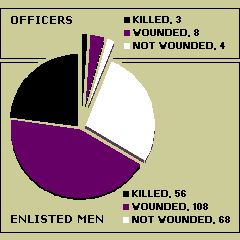
Following training operations off the West Coast, she was sent to the South Pacific to take part in the Guadalcanal operation, arriving in late August.
Replacing Farenholt (flagship of Capt. Robert G. Tobin, ComDesRon 12), Aaron Ward and Buchanan in the screen of Wasp (CV 7) after the Battle of the Eastern Solomons, Laffey, with Duncan, Lansdowne and cruisers Helena and Salt Lake City, collectively rescued 1,946 survivors (see photo above) on 15 September, when Wasp was torpedoed by the Japanese submarine I-19.
Laffey’s casualties at the Battle of Guadalcanal.

Source: Bureau of Personnel casualty report, NARA.
Two night gun-and-torpedo battles off Guadalcanal highlighted the remainder of Laffey’s short career. On 11–12 October, at the Battle of Cape Esperance, she was third in line following DesRon 12 destroyers Farenholt (flag) and Duncan, leading cruisers San Francisco (flagship of Rear Admiral Norman Scott, CTG 64.2), Boise, Salt Lake City and Helena and rear DDs Buchanan and McCalla in turning back a Japanese bombardment group during action in which Duncan was lost.
A month later, in the early hours of 13 November, she participated in the opening of the First Naval Battle of Guadalcanal. Second in line behind 1,500-tonner Cushing and ahead of Sterett and O’Bannon in the van of Rear Admiral Daniel J. Callahan’s 13-ship Task Group 67.4, she engaged Japanese battleships Hiei and Kirishima before sustaining a torpedo hit in the stern from destroyer Teruzuki. Her after magazines detonated shortly thereafter and she sank with a loss of 59 officers and men killed and 116 wounded. (Aaron Ward, Capt. Tobin’s flagship on this occasion, led the four rear destroyers—DesRon 12’s Barton and Monssen, both of which were also lost in this action, and the 2,100-ton Fletcher, which emerged undamaged. Laffey, Sterett and O’Bannon all received the Presidential Unit Citation for this action, as did Rear Admiral Scott’s flagship Atlanta and Admiral Callaghan’s flagship San Francisco.)
In 1992, a National Geographic expedition led by Dr. Robert Ballard discovered Laffey’s remains at a depth of nearly a half-mile off Guadalcanal. As reported in the video and book The Lost Fleet of Guadalcanal, Laffey is upright and largely intact from the bow to amidships, but her after third has disappeared. Both forward 5-inch guns are trained out to port, and her midships superstructure is holed by a 14-inch projectile from a Japanese battleship.
In April 2006, cruise ship Clipper Odyssey hove to over the position of Laffey’s remains. Mrs. Cary Webb Sears, daughter of LCdr. Hank, addressed the passengers and crew before leading a wreath ceremony.
In addition to her Presidential Unit Citation, Laffey earned three service stars on her Asiatic-Pacific Service Ribbon for participating in the following operations: